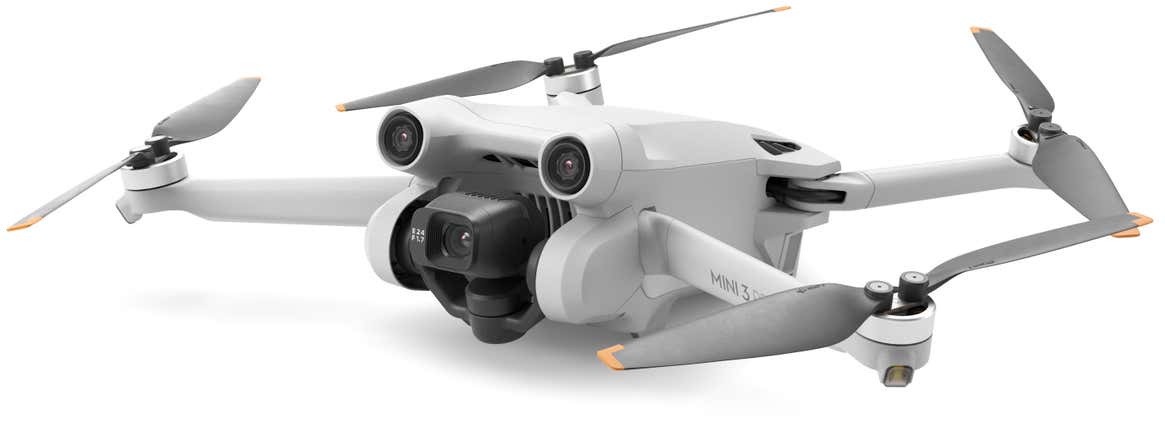The drone still weighs less than 250 grams, so recreational flyers don't need to register it with the FAA.
 |
| Image: DJI |
The amount of technology DJI has managed to squeeze into its Mini line of camera drones while keeping them lighter than 250 grams is even more impressive, with the new Mini 3 Pro adding obstacle avoidance, route planning, and the ability to automatically track a subject. But the upgrades come with a big price jump that might negate this drone’s reason for existing.
If you’re wondering why DJI heavily promotes that the new Mini 3 Pro weighs just 249 grams (it’s written right on the drone itself) it’s because drones weighing less than 250 grams being used for non-commercial recreational purposes (like capturing compelling aerial footage of a backyard BBQ) don’t need to be registered with the FAA. There’s still a long list of rules drone pilots need to adhere to to stay out of trouble, but it means that anyone can get started with the DJI Mini 3 Pro right out of the box, arguably its biggest appeal.
The DJI Mini 3 Pro features a design that’s very similar to the company’s older Mini drones, with arms that fold away for portability, and it carries forward many of the Mavic Mini 2's best upgrades. These include some minor improvements, like a boost to video transmission and operating range from 10 to 12 kilometers (~7.5 miles), as well as a minor bump to the maximum flight time, which is now up from 31 minutes to 34 minutes. For the first time, DJI Mini 3 Pro users can also swap in an optional larger battery that extends flight times to 47 minutes, and while it will push the drone’s takeoff weight past 250 grams when installed, there’s no obvious indication the drone is heavier as a result, aside from the battery not including the 249 grams branding. (The drone still does.)
DJI has also upgraded the Mini 3 Pro with a larger 1/1.3-inch CMOS camera sensor (the Mini 2 used a 1/2.3-inch sensor) that can capture stills at 48MP and 4K video at 60fps now, although capturing HDR footage limits the frame rate to 30fps. The camera’s improved gimbal now allows it to rotate a full 90-degrees sideways as well, for you monsters wanting to shoot video in portrait mode for easier sharing on social media and mobile devices.
 |
| Image: DJI |
The most compelling reason to upgrade or opt for the DJI Mini 3 Pro over previous models is the addition of forward, backward, and down-pointing sensors, which provides “Tri-Directional Obstacle Sensing” for the first time. Not only can the Mini 3 Pro automatically detect obstacles in its path, but it can also automatically fly around them with intelligent route planning by using DJI’s Advanced Pilot Assistance Systems (APAS) 4.0. The new sensors also allow the Mini 3 Pro to track a subject, which the drone will keep centered in frame while also ensuring the flight route it’s following is free of obstacles or hazards, even if a human pilot isn’t at the controls. That said, both features can be used when a human is steering the drone, as well.
The only limitation to the new autonomous functionality is that it also limits 4K and 2K video recording to 30fps, although 1080P at 60fps is still possible.
 |
| Image: DJI |
The other big upgrade arriving alongside the Mini 3 Pro is a new remote controller called the DJI RC that features a 5.5-inch touchscreen display built right into it, providing access to the DJI Fly app. The wireless remotes included with the previous DJI Mini drone models required the use of an attached smartphone for live video previews and accessing the Fly app, so this is a welcome improvement, as it means a 30-minute flight doesn’t also require a pilot’s smartphone to be draining its own battery for 30-minutes as well.
The new DJI Mini 3 Pro seems like a welcome improvement in every way imaginable, but the pricing could be problematic for some. At $450, the DJI Mavic Mini 2 wasn’t cheap, particularly since most choosing it in hopes of avoiding the FAA registration hassles wouldn’t be using it for profit, but it delivered excellent looking footage for the price and was easy to fly using the included DJI RC-N1 controller.
Tags:
Gadget
